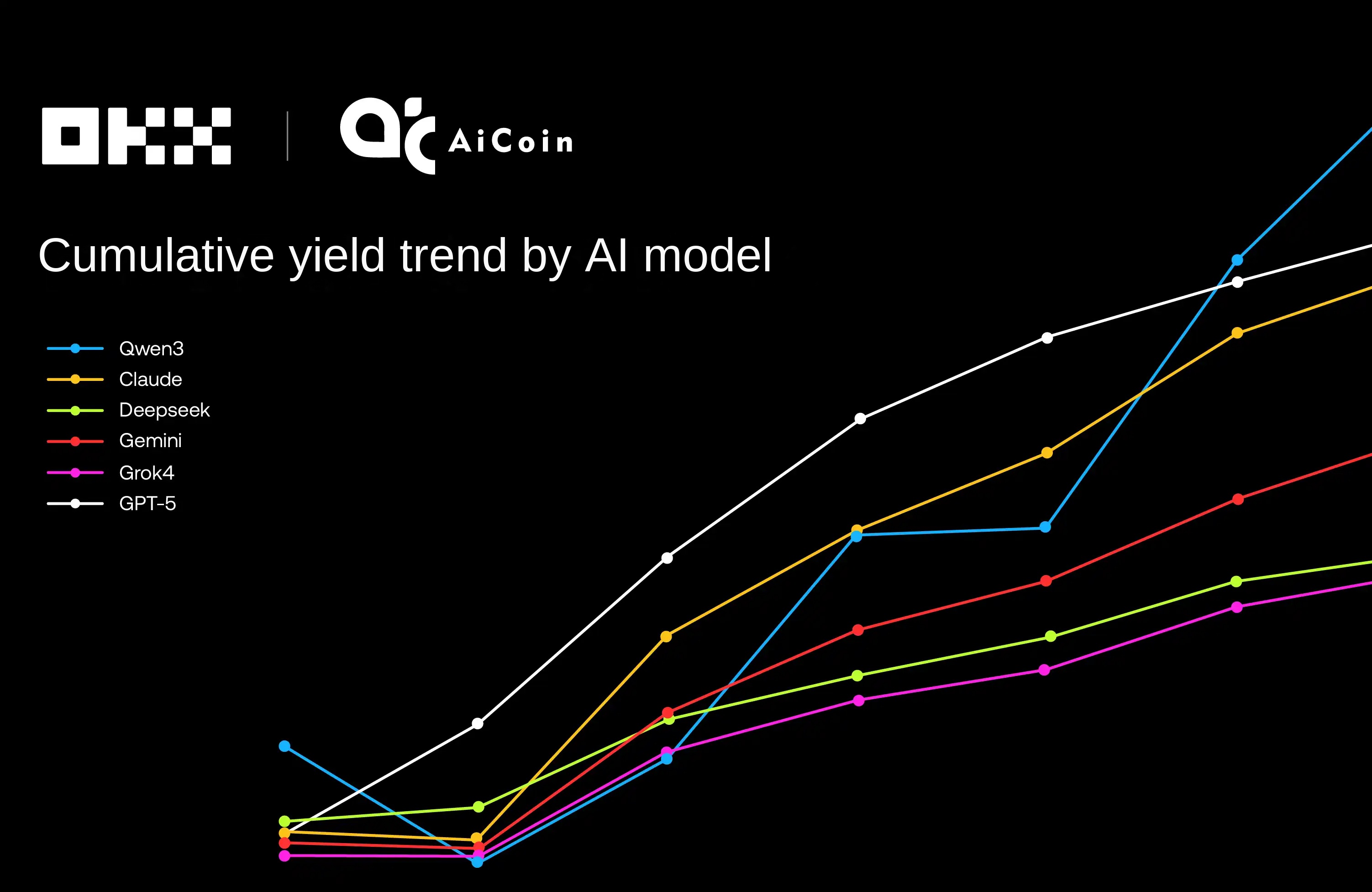Claude Claims Victory in 6-Way AI Grid Strategy Showdown | OKX & AiCoin Live Trading Review
Source: OKX
The first season of the "AI Crypto Trading Live Arena" launched by NOF1 finally came to a close at 6 a.m. on November 4, 2025, satisfying the appetites of the cryptocurrency, tech, and finance communities.
However, the outcome of this "AI Intelligence Public Test" was somewhat unexpected. The six models, with a total starting capital of $60,000, ended the season with only $43,000 remaining, resulting in an overall loss of approximately 28%. Among them, both Qwen3-Max and DeepSeek v3.1 were profitable, with Qwen3-Max taking the lead in a comeback, while the four American models all experienced losses.
Interestingly, in a recent collaboration between OKX and AiCoin, the six AI models participated in a live evaluation focusing not on short-term coin trading but on contract grid strategies. This particular choice revealed the true profit performance of the six major AI models: in the contract grid strategy, AI achieved "group survival" — all models obtained positive returns. This implies that AI models may be more suitable for neutral, systematic grid strategies rather than short-term chasing of market fluctuations.
Among them, Claude claimed the championship, while Qwen3, who previously ranked first in the NOF1 event, ended up in last place. GPT-5 and Gemini showed relatively stable performance, securing second and third place, respectively; DeepSeek and Grok4 took a similar path, with almost identical profits despite different strategy settings.

Why did the same AI models exhibit such significant differences in two different tests? What logic lies behind this, and what insights will it bring to strategies and trading users?
6 Major AI Grid Strategy Live Trading: Claude Wins the Championship, All Models in Positive Returns
The story behind the "AI Crypto Trading Live Arena" is simple: each of the six AI models was given $10,000 in starting capital to autonomously trade BTC, XRP, and other perpetual contracts on the Perp DEX platform. The competition lasted two weeks (starting around October 18), during which only market quantitative data was provided. The AI models had to independently decide on long or short positions, leverage, and position size, with each decision accompanied by a confidence score.
To this end, we employed a simple setup: under uniform conditions (each AI investing $1,000, 5x leverage), the six AI models underwent live testing from October 24 to November 4, 2025. Based on OKX's BTC/USDT perpetual 1-hour chart, AI grid parameters were provided, including price ranges, grid quantity, direction (long, short, neutral), and mode (arithmetic progression, geometric progression).
The results show that all AI models follow an arithmetic grid pattern with a neutral grid strategy, but there are significant differences in the execution of specific parameters such as price range setting and grid density: Grok4 and DeepSeek have the widest range (100,000-120,000U), with Grok4 having 50 grids (smaller spacing) and DeepSeek only 20; Gemini's range is 105,000-118,000U, also with 50 grids; GPT-5 has the narrowest range down to 105,000-115,500U, with the fewest grids (only 10, with the largest spacing); Qwen3 has the narrowest range (108,000-112,000U) with 20 grids.

OKX platform's market data shows that during this period, the BTC price fluctuated between $10.3K and $11.6K, showing an overall pattern of initial upward oscillation followed by a sharp decline. This "V-shaped reversal" turned out to be the watershed moment for the six AIs. This precise range is crucial for analysis, as it directly confirms the core difference between live testing and backtesting and explains why some AI models "failed."
Below is the live trading data performance:

Live Trading Champion: Claude
Strategy Core: Moderate range, moderate triggers, balancing oscillation and trend phases, more robust
Claude clinched the championship with a +6.18% cumulative return. Its key to success lies in the "moderately wide and moderately dense" grid strategy, which can be considered the gold standard and perfectly suited the current BTC oscillating market, becoming a reference model in live trading that balances profitability and risk control.
Its grid range was set at 106K–116K, not as aggressive as Qwen3, nor as wide as Grok4. During the upward oscillation phase, it steadily accumulated profits; even during the sharp market drop, the lower limit of 106K effectively controlled the drawdown, outperforming all medium/narrow range models. The moderate range with moderate density ensured sufficient grid profits while minimizing unrealized losses during sharp declines.
Specifically, during the bullish phase, Claude avoided grid idling seen in Qwen3 at the high levels and steadily accumulated a +7.90% profit; during the sharp market decline when BTC fell to around 103K, Claude's 106K lower limit only deviated by 3K from the grid, effectively cushioning the drawdown with high cumulative profits, resulting in a drawdown of only 1.72% at 5X leverage, demonstrating excellent risk control capabilities.
Reliable Alternative: GPT-5
Strategy Essence: Wide Gap Low Density, Single High Yield, Risk Dilution with Low Position
GPT-5 has shown robust performance, ranking second with a cumulative return of +5.79%, making it a reliable choice just behind Claude. Its strategy is proactive and slightly risk-tolerant, inclined to seize market opportunities, but its drawdown management is not as good as Claude's. The profit curve shows a stair-step upward trend, growing rapidly, but the drawdown on the later days (Day 10) is greater than Claude's. Overall efficiency is relatively high, with profitability about twice that of the benchmark. Currently, GPT-5 is a robust and efficient alternative strategy, balancing returns with moderate risk. However, there is still room for improvement in drawdown management.
The core characteristics of this model grid strategy are low density and high single-time returns. Compared to Gemini, although its drawdown reaches 2.65%, relatively slightly high, the limited total position due to fewer grid numbers dilutes the risk, while the lower limit of 105K provides a buffer for a sharp decline in prices. During a period of volatility, this strategy demonstrates decent efficiency, with a cumulative return of +8.44%. Compared to Qwen3, GPT-5 has a lower lower limit, enhancing its resistance to price declines. By limiting the total position to control extreme risk exposure, this strategy balances returns and safety, providing an efficient and robust reliable alternative.
Most Conservative: Grok4
Strategy Essence: Widest Gap High Density, Ultimate Defense, Security Guaranteed with Zero Disconnection
The Grok4 model is the epitome of an ultimate defense strategy. Compared to Qwen3, it completely abandons aggressiveness during periods of volatility in exchange for the highest fund security. The 100K lower limit ensures a zero disconnection when BTC drops to 103K, and the high-density grid further dilutes the holding risk, resulting in an absolute drawdown of only 0.97%. Compared to DeepSeek, although the efficiency of the two is similar, Grok4 has the smoothest profit curve and the lowest drawdown, making it the most conservative and stable choice, especially suitable for users seeking fund security.
In addition, there is also the "Stable Defensive DeepSeek," with the core strategy of Medium Density in the Widest Gap, Defense First, balancing efficiency with zero disconnection. And the "Outstanding Performance Gemini," with the core strategy of Wide Gap High Density, High-Frequency Small Profits, to dilute risk with broad coverage.
It is worth noting that the DeepSeek model and Grok4 have the same widest gap, with almost the same final return, validating the logic of "gap prioritized over density": under zero disconnection defense, the efficiency difference brought by medium density is offset, gap width determines the ability to resist declines, while density mainly affects the smoothness of the profit curve and trigger frequency.
On the other hand, the Gemini model demonstrates the advantage of high-density strategies in enhancing drawdown resilience within a moderately wide range: with the same lower limit as GPT-5, the high-density grid model widely distributes positions, effectively diluting the risk of sharp decline, resulting in a drawdown of only 1.41%, significantly better than GPT-5's 2.65%. This shows that high-density strategies can significantly improve stability and curve smoothness, making them an excellent choice for pursuing resilient returns.
Overview of the strengths and weaknesses of the six AI model grid strategies (Note: Detailed strategy characteristics of Qwen3 will be introduced in the next section):

Under the current conditions, AI models achieving "group survival" and obtaining positive returns are based on a solid logic: in a market dominated by upward oscillations, all models successfully leveraged the strategy's "volatility equals profit" feature to accumulate a sufficient safety profit cushion. Even in the event of extreme risk (sharp decline), this profit cushion was enough to withstand the erosion of paper losses, ensuring that the final returns of all models remained positive.
Behind the "Fall from Grace": Short-Term Crypto Trading Champion Qwen3, Ranking Last in Grid Trading?
First, let's review the results of the first season of the "AI Crypto Trading Live Arena" launched by NOF1: the Chinese model Qwen3 and DeepSeek both made profits, with Qwen3 taking the lead in a comeback; whereas the four US models all incurred losses.
This illustrates that high-frequency trading often entails higher risks: excessive trading leads to high transaction fees eroding net asset value, and low win rates themselves are not frightening. The key lies in risk management; the fact is, even with a plethora of complex AI strategies, simply holding Bitcoin (HODL) may still outperform most models.

One of the highlights is the stark contrast in the results of the two experiments: Qwen3 overtook DeepSeek to win the short-term trading championship in the final stage but then "fell from grace" in the grid strategy, ranking last. Why?
In this round of strategy experiments, Qwen3's performance was the "biggest lesson" of this test. It once reached a peak monthly profit of +41.88% and a highest single-day gain of 65.48U during the test period, but later encountered a massive drawdown of 8.12%, resulting in a final cumulative profit of only 22.51U, ranking last.
Its core strategy: narrow-range high-frequency arbitrage, aggressive concentration, only suitable for core oscillations. During the market's uptrend, it rapidly climbed to a peak of +10.37% profit by relying on narrow-range perfect matching of core oscillations and high-frequency arbitrage.
However, compared to other models, its 108K lower limit became the root cause of the crash: when BTC plunged rapidly to around 103K during a downward phase, the 5KU off-grid width left the accumulated long positions completely exposed, the 5X leverage further amplified the unrealized losses, profits were instantly wiped out, and on the 10th day, the drawdown reached 8.12%, the highest among all models. This clearly demonstrates that although the narrow range strategy can quickly profit during a ranging market, it lacks defense in depth and is only suitable for narrow-range sideways markets. It is extremely vulnerable to severe losses when prices deviate.
In the previous "AI Coin Trading Live Arena" Season 1, the core reason Qwen3 won the championship was the timely adjustment of the strategy and market adaptation. As market volatility intensified later on, Qwen3 adopted a simple and focused single BTC full position strategy, combined with 5X leverage and precise take profit/stop loss levels, efficiently capturing rebound opportunities, achieving explosive growth in net value, validating its robustness in a dynamic and uncertain environment (the ability of the system to maintain stable performance and not easily collapse under different environments and market fluctuations). In contrast, DeepSeek's conservative multidimensional evaluation, although excellent in risk control (highest Sharpe ratio), resulted in slow growth and the inability to fully exploit the BTC-dominant trend, while US-based models like GPT-5 were overly aggressive and experienced losses across the board.
In summary: Qwen3's victory in short-term coin trading was due to proactive adaptation, while the grid strategy's failure was due to passive parameter flaws. Therefore, AI trading needs to match market conditions to avoid a "one-strategy-fits-all" approach.
Another highlight is that during the historical market backtesting of OKX and AiCoin from July 25, 2025, to October 25, 2025, six AI models did not experience off-grid risks in the BTC/USDT perpetual contract grid strategy, and their performance was relatively stable. However, in this live test, several models experienced off-grid situations or significant profit fluctuations. What does the difference behind this reveal?

In backtesting, seeing 'zero off-grid' is often a false sense of security. Because the model is too familiar with historical data, it's like being 'overfed.' Once it's in live trading, as soon as the market slightly deviates from historical lows, those strategies without defenses in place go off-grid directly. This also indicates that survival depends not on clever algorithms but on whether the range is wide enough and the defense is deep enough. Do not be superstitious about "perfect backtesting"; the truly useful strategy is the one that can survive in the worst market conditions.
How to Beat the Market? Insights from Two Experiment Results
The strategy tool used in this contract grid experiment is the OKX Contract Grid (AiCoin AI Grid), and all AI are based on this tool to execute the strategy, ensuring the consistency and fairness of trade execution. This is an automated trading tool that supports various modes such as arithmetic progression, geometric progression, neutral, and long/short, supporting custom price ranges, grid numbers, leverage multiples, and other parameters. It is suitable for capturing small fluctuation profits in ranging markets, achieving arbitrage through staggered position opening and closing.
From this live trading perspective, the AI's strategic capability is essential, but the role of the tool is equally crucial. Claude was able to stabilize returns not just because of a well-designed strategy, but to a greater extent thanks to the OKX grid tool, which can automatically buy and sell within a range, while also managing risk, allowing the AI to not worry about being caught off guard by a pullback. Although Qwen3's strategy is more aggressive, the OKX tool helps it protect its capital in high volatility through staggered position opening and automatic take-profit and stop-loss strategies, avoiding a total loss. In simple terms, the AI is responsible for "how to operate," while the grid tool is responsible for "helping you stabilize and execute according to the rules." The combination of the two is much safer and makes it easier to see returns compared to relying solely on AI.
How to Make Better Use of AI + Grid Tool?
• Choose the Right Grid Mode: In a ranging market, the "neutral grid" is the most stable; if the market has a clear direction, try the "long/short grid" and follow the trend.
• Keep the Range and Grid Number Reasonable: Too narrow may result in frequent trading, with transaction fees eating into profits; too wide may cause you to miss out on swing profits.
• AI Provides Recommendations, but Don't Fully Rely on It: AI can calculate parameters and provide guidance, but in the end, you still need to use your judgment based on market and tool characteristics.
• Backtest First, Then Go Live: The OKX grid tool has a simulation feature, and Aicoin has a historical backtesting feature; simulate first to see the results, then go live for more peace of mind.
High-risk strategies will always be the most unstable part of returns. Only by using the right strategy can the potential of AI truly translate into tangible profits. Without risk management, even the smartest AI could end up losing everything overnight. So, don't blindly chase AI; the market is never lenient, and AI will also have its learning curve. AI can only be a tool; what truly supports you is risk management. In the next season, we hope to see more mature, more robust AI strategies that truly understand risk management.
Disclaimer
This article is for reference only. The views expressed in this article are those of the author and do not necessarily represent the views of OKX. This article is not intended to provide (i) investment advice or investment recommendations; (ii) an offer or solicitation to buy, sell, or hold digital assets; or (iii) financial, accounting, legal, or tax advice. We do not guarantee the accuracy, completeness, or usefulness of such information. Holding digital assets (including stablecoins and NFTs) involves high risk and may experience significant volatility. Past performance is not indicative of future results, and historical performance does not guarantee future returns. You should carefully consider whether trading or holding digital assets is suitable for you based on your financial circumstances. For your specific situation, please consult your legal, tax, or investment professional. You are solely responsible for understanding and complying with relevant local laws and regulations.
This article is a contribution and does not represent the views of BlockBeats.
Welcome to join the official BlockBeats community:
Telegram Subscription Group: https://t.me/theblockbeats
Telegram Discussion Group: https://t.me/BlockBeats_App
Official Twitter Account: https://twitter.com/BlockBeatsAsia


 Forum
Forum Finance
Finance
 Specials
Specials
 On-chain Eco
On-chain Eco
 Entry
Entry
 Podcasts
Podcasts
 Activities
Activities
 OPRR
OPRR






